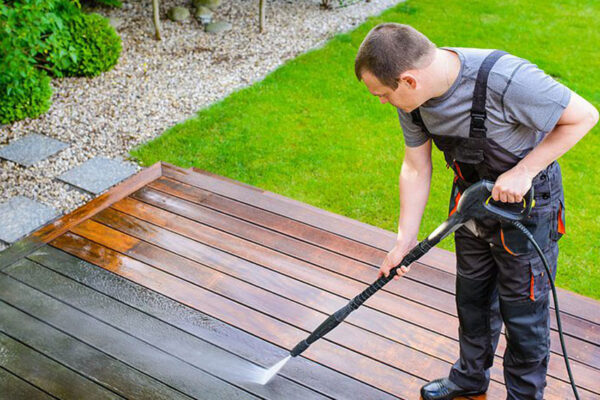Pressure washing is not a one-season job—it’s a year-round maintenance practice that keeps your home looking fresh, prevents long-term damage, and boosts curb appeal. Adapting your cleaning routine to the season ensures better results and protects your investment. Whether it’s removing winter grime, tackling summer mildew, or preparing for fall storms, seasonal care makes a big difference.
How Does Seasonal Pressure Washing Protect Your Home?
Seasonal pressure washing removes dirt, mold, mildew, pollen, and algae before they cause structural or cosmetic damage. A seasonal exterior maintenance guide helps you target cleaning tasks when they’re most effective.
- In spring, you’re washing away winter salt and grime.
- In summer, you’re targeting mold, algae, and sun-baked stains.
- In fall, you’re preparing for wet weather and clogged gutters.
- In winter (in milder climates), you’re preventing moisture-related decay.
Regular cleaning also extends the lifespan of paint, siding, decks, and driveways by preventing buildup that can cause surface breakdown.
What Should Be on Your Spring Exterior Cleaning Checklist?
Spring is prime time for deep cleaning after months of cold, wet, or snowy weather. A proper spring exterior cleaning checklist includes:
- Wash siding and brickwork to remove salt stains and mildew.
- Clean decks and patios to prepare for outdoor use.
- Rinse windows and shutters to clear pollen and dust.
- Flush gutters and downspouts to ensure proper drainage.
- Pressure wash walkways and driveways to remove winter residue.
Use a medium-pressure nozzle (1,500–2,000 PSI) for most home exteriors, and opt for eco-friendly detergents to protect plants and soil.
What Summer Pressure Washing Tasks Keep Surfaces in Top Shape?
High heat and humidity in summer create ideal conditions for mildew, algae, and mold growth. Summer driveway and deck cleaning tips focus on keeping outdoor areas safe and attractive:
- Driveways: Remove oil stains and tire marks before they become permanent.
- Decks and patios: Use lower PSI (1,200–1,500) for wood to prevent splintering.
- Pool areas: Wash pool decks to prevent slip hazards from algae buildup.
Avoid pressure washing during the hottest part of the day to prevent rapid drying that can leave streaks or soap residue.
How to Prepare for Fall Home Maintenance Pressure Washing
Fall is about protection before winter sets in. Fall home maintenance pressure washing should focus on:
- Clearing leaves, dirt, and debris from gutters and siding.
- Washing mildew-prone areas before damp weather increases growth.
- Cleaning exterior walls before applying sealants or paint.
- Pressure washing driveways to remove organic matter that can stain.
Schedule washing before temperatures drop below 50°F to allow proper drying.
What Winter Pressure Washing Precautions Should Homeowners Follow?
Cold weather makes pressure washing tricky. Winter pressure washing precautions include:
- Avoid freezing conditions: Never wash when temperatures are below 40°F; water can freeze on contact and damage surfaces.
- Focus on problem areas: In milder climates, target moldy siding or salt-covered driveways.
- Protect your equipment: Always drain hoses and pumps after use to prevent freeze damage.
If you live in a snow-prone area, wait until the occasional mild winter day to handle urgent cleaning.
How to Build a Year-Round Exterior Cleaning Schedule
A seasonal exterior maintenance guide helps you plan and prevent last-minute repairs.
| Season | Priority Areas | Recommended PSI | Special Notes |
|---|---|---|---|
| Spring | Siding, gutters, patios | 1,500–2,000 | Use mild detergent |
| Summer | Driveways, decks, pool areas | 1,200–2,500 | Avoid peak sun hours |
| Fall | Walls, gutters, driveways | 1,500–2,000 | Prep before sealing surfaces |
| Winter | Salt removal, mold-prone spots | 1,500 | Only in above-freezing temps |
Should You DIY or Hire a Professional for Seasonal Pressure Washing?
DIY pressure washing is cost-effective for small jobs but comes with risks if you’re not familiar with proper PSI levels or ladder safety. Hiring a professional ensures:
- Correct pressure settings for each surface.
- Eco-friendly detergent use.
- Thorough cleaning in hard-to-reach areas.
Professionals also know how to adapt techniques for different seasonal needs, such as softer washing in summer for painted siding or winter-safe methods in colder climates.
Essential Safety Tips for Year-Round Pressure Washing
Pressure washing is powerful—and potentially dangerous—if not done correctly.
- Wear protective gear: Safety goggles, gloves, and closed-toe shoes.
- Check electrical hazards: Avoid spraying outlets, wiring, or light fixtures.
- Mind your surroundings: Keep pets and children indoors during cleaning.
- Test pressure first: Always test a small area before full cleaning.
Common Mistakes to Avoid When Pressure Washing in Different Seasons
Many homeowners unintentionally cause damage by using the wrong methods for the season. Common errors include:
- Using too much pressure on aged or weather-damaged surfaces.
- Washing in freezing temperatures which can cause ice buildup and cracking.
- Skipping pre-rinse and post-rinse steps, leaving soap residue.
- Neglecting seasonal adjustments for PSI and detergent strength.
Avoiding these mistakes ensures your home’s exterior stays in top condition year-round.
Final Thoughts
By following seasonal pressure washing tips for homeowners, you’ll not only keep your home looking its best but also protect its surfaces from costly long-term damage. Whether it’s following a spring exterior cleaning checklist, using winter pressure washing precautions, or focusing on summer driveway and deck cleaning tips, adjusting your approach to the season ensures safer, more effective cleaning.
Next, we’ll explore how professional pressure washing services can extend your home’s lifespan while saving you time and effort.


